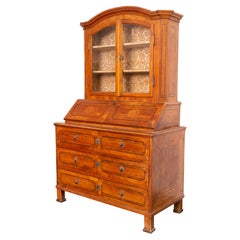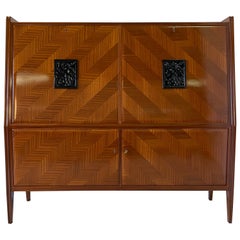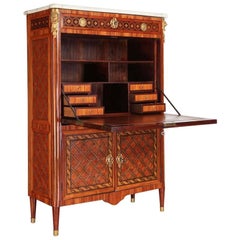Pintér Aukcioshaz Kft Secretaires
to
Height
to
Width
to
Depth
to
1
1
1
1
1
1
1
1
1
1
1
1
1
Copf Style Cherry Inlay Secretaire Cabinet, ca. 1800
Located in Budapest, HU
Early 19th century hutch, (combination of a writing secretaire and a glass cabinet) in Copf-Style. The pine corpus has a cherry veneer, and has fine...
Category
Antique Early 19th Century European Louis XVI Secretaires
Materials
Cherry, Pine
Related Items
Italian Mahogany Secretaire Cabinet, 1950s
Located in Meda, MB
Precious cabinet secretaire produced in Italy in the 1950s,
The whole cabinet is veneered in mahogany with a fine solid wood carving in the center of the two doors representing two b...
Category
Vintage 1950s Italian Mid-Century Modern Cabinets
Materials
Mahogany, Maple
French Ormolu-Mounted Marqueterie Secretaire Abattant, Cabinet, 1775
Located in Rome, IT
Important French ormolu-mounted, kingwood, tulipwood and stained sycamore marqueterie and parquetry secretaire abattant with rectangular moulded white marble top, above a frieze draw...
Category
Antique 18th Century French Louis XVI Secretaires
Materials
Wood
H 55.91 in W 37.01 in D 15.75 in
Louis XVI Desk/Secretaire a Abattant c. 1790-1800
Located in Pasadena, CA
This is a very good example of a late 18th century Louis XVI Secretaire a Abattant. The secretaire is crafted of solid walnut and is a generous 39.5" wide. The fall front when down r...
Category
Antique Late 18th Century French Louis XVI Secretaires
Materials
Walnut
English Antique Georgian Inlaid Solid Oak Bureau / Secretaire c.1800
Located in Leicester, GB
A stunning English Georgian bureau. This bureaux is from the Georgian era, just after 1800. Fabulous color and patina to the solid oak finish. The whole piece of furniture is made of...
Category
Antique Early 1800s English Georgian Secretaires
Materials
Oak
H 42.52 in W 40.16 in D 20.48 in
French Louis XVI Secretaire Abattant / Secretary desk, circa 1800
Located in Lucenec, SK
The secrétaire à abbatant or fall front desk is nearly identical to the desk 5th President James Monroe brought back from France in 1797. These desks are ...
Category
Antique Early 19th Century French Louis XVI Desks
Materials
Brass
Secretaire Writing Cabinet in Antique Biedermeier Style Mahogany veneer
Located in Berlin, DE
High quality rosewood veneer on solid conifers. Conical body on profile frames. Base in the front, between four drawers, straight flap with shield-shaped filling. Behind it is a richly divided compartmental division of a bent temple-shaped central compartment with mirrored full columns, flanked by star-starved drawers. Over cantilevered profile cornice flat gypsum, stepped with oval cover plate. Front. All drawers and backboard made of solid wood. So-called pyramid furniture...
Category
Antique 19th Century German Biedermeier Secretaires
Materials
Mahogany
H 63 in W 36.23 in D 21.66 in
King George I Ambassadorial Secrétaire-Cabinet
Located in New Orleans, LA
This highly important secrétaire-cabinet was crafted for and specially ordered by King George I for the British Ambassador to Russia. From its craftsmanship and materials to its exceptional artistry, it is a work of royal and historic significance that exudes power in each and every detail. The broken pediment at its apex features the simplified royal coat of arms bearing the king’s crown, while the interior is adorned by portraits of the British Royal Family. Placed within the ambassador’s St. Petersburg home, this entirely unique piece of furniture would have been a potent reminder of England's grandeur and political importance.
Relations between England and Russia during this period were at an all-time high. Peter the Great had traveled to England in 1698 as part of his widely known “Grand Embassy” tour, wherein he attempted to gain foreign support against the Ottoman Empire. He spent a period of nearly four months there, meeting with King William III and his court on numerous occasions. Noted academic Arthur MacGregor wrote concerning the impact of the trip, “For two decades following Peter's visit, British influence in Russia reached a peak. It manifested itself in social custom, in craft practice and in ships and naval organization... it reached a significant sector of the population before relations cooled once again and the two nations pulled back from this era of unprecedented cordiality.”
First and foremost, however, it is a reminder of British might and influence. By the reign of King George I, England had come into its own as a world power. Unique in its design, this cabinet is a reflection of the country’s might. It is crafted from the highest-quality solid walnut and burr walnut adorned by gilded lock plates and engraved hinges. The presence of ormolu at its apex and lining the doors was a rarity for this period, and its addition makes manifest the importance of the design.
The outer doors open to reveal multiple interiors, including fifteen separate drawers around a central cupboard; the cupboard doors each bear mezzotint portraits of George I and his father, Ernest Augustus, Elector of Hanover. An etching after the portrait of George I dating to circa 1716 is in London’s Royal Academy. A second, inner pair of doors are adorned by mezzotints of the Prince and Princess of Wales (later Queen Caroline and George II), which are both after portraits by Sir Godfrey Kneller dated 1716 in the Royal Collection. A final portrait is revealed on the very interior of the cabinet, where a mezzotint of Frederick, Anne, Amelia and Caroline, children of the Prince of Wales, resides. An etching (circa 1715-1720) after this portrait can be found in the National Portrait Gallery (London).
Apart from its abundance of royal portraiture, the cabinet features stunning painted decoration, including floral designs as well as clouds, birds and trees in a bucolic motif reminiscent of Eden. Its lower portion is a study in both form and function, featuring a fitted secrétaire-drawer above three additional drawers for storage. The cabinet appears in The Shorter Dictionary of English Furniture by R. Edwards from 1964, a text that is regarded as the bible of British furniture design. Edwards describes it as a “writing cabinet...given by George I to the British Ambassador at the Russian court.”
The cabinet was likely made for the 18th-century German diplomat and writer Friedrich Christian Weber, who represented English interests at the Russian court from 1714 until 1719. Although Weber’s tenure as ambassador was relatively short, while in St. Petersburg, he authored his account entitled Das veraenderte Russland (The Present State of Russia), which was published in three volumes in 1721, 1739 and 1740. It may, however, also have been made for George Douglas, 2nd Earl of Dumbarton, who served as ambassador alongside Weber in 1716. Diplomatic relations ceased between the two countries in 1721.
In 1928, the cabinet appeared for sale at the International Exhibition of Antiques & Works of Art in Olympia. It had previously been in the collection of the Woltner family of Bordeaux, the celebrated vintners who owned the estate Château Laville Haut-Brion and produced wine of the same name. According to the family, Monsieur Woltner was given the cabinet as a gift from an aunt who lived in Russia for many years. After leaving the Woltner collection, the cabinet was acquired by William Berry...
Category
Antique 18th Century English Georgian Secretaires
Materials
Brass
19th Century Biedermeier Cherry Fall Front Desk / Secretaire
Located in Darmstadt, DE
Introducing a stunning late Biedermeier Slant-Front Secretary, crafted from solid cherry wood in the 1840s. This exquisite piece of furniture features three drawers spanning the enti...
Category
Antique 19th Century German Biedermeier Desks and Writing Tables
Materials
Spruce, Cherry
Baroque Cabinet with Secretaire, Germany 1750
Located in Belmont, MA
Add timeless elegance to your home or office with this original Baroque cabinet featuring a built-in secretary desk, crafted in Germany circa 1750. This exquisite piece originates fr...
Category
Antique 1750s German Baroque Cabinets
Materials
Walnut
18th Century Austrian Baroque Secretaire/ Bureau Cabinet, Nutwood, AT ca. 1770
Located in Lichtenberg, AT
Remarkable 18th Century baroque secrétaire/ bureau cabinet elaborately handcrafted in the period around 1770 in Austria. As former part of the inventory of an old Upperaustrian castl...
Category
Antique Late 18th Century Austrian Baroque Secretaires
Materials
Brass
H 81.1 in W 51.18 in D 25.59 in
Biedermeier Secretaire, Cherry Veneer, Inlays, Brass, South Germany circa 1830
Located in Regensburg, DE
Large, original Biedermeier Secretaire from South Germany around 1840.
Cherry veneered on softwood and solid cherry. Solid cherry solid columns with carved Corinthian capitals.
Pro...
Category
Antique 1830s Austrian Biedermeier Secretaires
Materials
Iron, Tin
H 72.45 in W 46.86 in D 25.4 in
Desk, Secretaire, Moorish Inlays
Located in Buenos Aires, Argentina
Desk - Secretaire - Moorish inlays
Origin and marquetry of Morocco
Circa 1930. very good condition
Leather interior with wear and tear
Measurements w...
Category
Vintage 1930s Moroccan Moorish Secretaires
Materials
Wood


